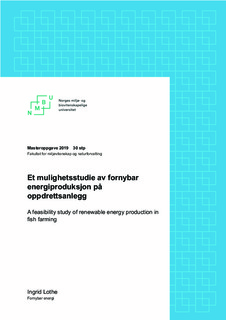| dc.contributor.advisor | Trømborg, Erik | |
| dc.contributor.author | Lothe, Ingrid | |
| dc.date.accessioned | 2019-08-22T07:54:32Z | |
| dc.date.available | 2019-08-22T07:54:32Z | |
| dc.date.issued | 2019-05 | |
| dc.identifier.uri | http://hdl.handle.net/11250/2609747 | |
| dc.description.abstract | Som et resultat av en stadig økende etterspørsel, opplever oppdrettsnæringen utfordringer i forbindelse med sykdom, tilgjengelig areal og miljøkonsekvenser i områdene de etableres i. På bakgrunn av dette åpnet Fiskeridepartementet i 2015 for at bedrifter kunne søke om utviklingskonsesjon for særlig bekostede og innovative oppdrettsteknologier. Roxel Aqua søkte i 2017 om utviklingskonsesjon til å fremstille deres forslag, Octopus. Octopus benytter en jackup-rigg som forsyningsbase til et offshore oppdrettsanlegg som dermed kan etableres utenfor kysten. Som en konsekvens av oppdrettsanleggets offshoreplassering, vil det oppstå utfordringer i forbindelse med miljøvennlig konsumering av energi, da jackup-rigger forbruker energi fra dieselaggregat. Fornybar energiteknologi montert på oppdrettsanlegg er for tiden svært aktuelt, og det har derfor vært ønskelig å implementere denne teknologien på Octopus. På bakgrunn av dette er det beregnet at et oppdrettsanlegg bestående av 12 merder og 60 m2 bruksareal, vil ha et årlig energibehov på 339 080 kWh. Ved hjelp av sol- og vindenergi vil energiproduksjonen kunne variere mellom 22% og til tider mer enn det dobbelte av energibehovet. Den teknologiløsningen som gir høyest andel lokalprodusert fornybar energi, er kombinasjonen av solenergi og vindturbinmodell med 100 kW installert effekt. Sammen vil disse produsere i overkant av energibehovet til anlegget, med unntak av mars. Av teknologiene med lavest klimaavtrykk er det landstrøm og kombinasjonen av sol- og vindenergi med 100 kW installert effekt som gir lavest utslipp gjennom teknologienes livssyklus. I vurderingen av økonomi er det landstrøm som oppgis med lavest investeringskostnad, men dette vil avhenge av avstanden mellom Octopus og tilkoblingspunkt med nødvendig infrastruktur på land. Landstrøm vil også ha en årlig utgiftspost i forbindelse med forbruk av elektrisk strøm fra strømnettet. Teknologikombinasjonen solenergi og 100 kW installert vindeffekt vil i følge beregningene ha en investeringskostnad større enn landstrøm, men den forbrukte energien vil i dette tilfelle være egenprodusert og dermed kostnadsfri. | nb_NO |
| dc.description.abstract | As a result of an increasing demand, the aquaculture industry is experiencing challenges due to fish disease, available area and environmental impacts in the established areas. In view of this, The Norwegian Ministry of Fisheries opened in 2015 to allow companies to apply for a development license for particularly costly and innovative farming technologies. In 2017, Roxel Aqua applied for a development license to present their suggestion, Octopus. Octopus uses a jackup rig as a supply base for an offshore fish farm. As a consequence of the facility's offshore location, environmentally friendly consumption of energy will become a challenge, as jackup rigs consume energy from diesel aggregates. Renewable energy technology installed on fish farms is currently very relevant, and it has therefore been desirable to implement this technology on Octopus. Based on this, it is estimated that an aquaculture plant consisting of 12 fish cages and 60 m2 of utility area will have an annual energy requirement of 339 080 kWh. Using solar- and wind energy, the energy production on Octopus can vary between 22% and sometimes more than twice the energy requirement. The technology solution that provides the highest production of renewable energy is the combination of solar energy and wind turbine model with 100 kW installed power. Together, these will produce in excess of the energy requirement of the plant, with the exception of March. The technologies with the lowest climate footprint is power from onshore electricity grid, and the combination of solar and wind energy with 100 kW installed power. In the economical calculations, the connection to onshore electricity grid is stated with the lowest investment cost, but this will depend on the distance between Octopus and the connection point with the necessary infrastructure on land. The connection to onshore electricity grid will also have an annual expense item due to consumption of electricity from the electricity grid. The technology combination with solar energy and 100 kW installed wind power will, according to the calculations, have a higher investment cost than onshore electricity grid, but the energy consumption will in this case be self-produced and thus free of charge. | nb_NO |
| dc.language.iso | nob | nb_NO |
| dc.publisher | Norwegian University of Life Sciences, Ås | |
| dc.subject | Solenergi | nb_NO |
| dc.subject | Vindenergi | nb_NO |
| dc.subject | Fornybar energi | nb_NO |
| dc.subject | Fiskeoppdrett | nb_NO |
| dc.title | Et mulighetsstudie av fornybar energiproduksjon på oppdrettsanlegg | nb_NO |
| dc.title.alternative | A feasibility study of renewable energy production in fish farming | |
| dc.type | Master thesis | nb_NO |
| dc.description.version | submittedVersion | nb_NO |
| dc.source.pagenumber | 70 | nb_NO |
| dc.description.localcode | M-FORNY | |
